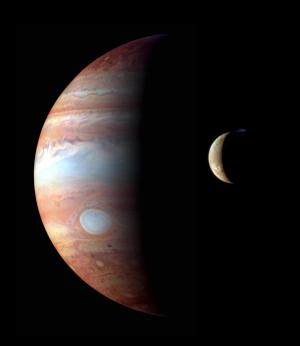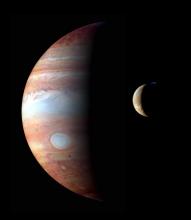Moon and Jupiter [1]
Most of the solar system’s planets are surrounded by radiation belts — zones where charged particles are trapped by the planet’s magnetic field. Earth, for example, is encircled by the Van Allen belts. Spacecraft that pass through these belts need special shielding to protect their electronics.
But the most powerful belts encircle Jupiter, the giant of the solar system. Its magnetic field is far stronger than Earth’s, so it traps more charged particles from the Sun. Other particles come from its volcanic moon Io. These sources create radiation belts that could kill an unprotected person in hours.
A spacecraft that’s currently orbiting Jupiter has special protection against the radiation. Juno’s computer and much of its other electronics are housed inside a titanium vault. The vault is about as big as the trunk of an SUV, and its walls are almost half an inch thick. And even with that extra level of protection, Juno’s orbit is carefully controlled to keep the craft out of the most dangerous radiation zones.
Juno is measuring Jupiter’s magnetic and gravitational fields. Its readings should help scientists determine how Jupiter is put together. And that will help them learn more about how it generates its magnetic field — creating “dead zones” around the giant planet.
Jupiter is in good view tonight. It stands quite close to the Moon, and looks like a brilliant star. The true star Spica stands below the pair. More about Spica tomorrow.
Script by Damond Benningfield
Keywords:
- Juno Mission [3]
- Jupiter [4]
- Radiation [5]


